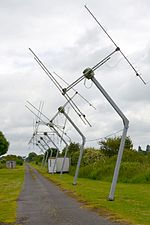Lord's Bridge railway station
1862 establishments in EnglandDisused railway stations in CambridgeshireFormer London and North Western Railway stationsPages with no open date in Infobox stationRailway stations in Great Britain closed in 1968 ... and 2 more
Railway stations in Great Britain opened in 1862Use British English from January 2018

Lord's Bridge was a railway station on the Varsity Line which ran between Oxford and Cambridge. Situated in the north of the parish of Harlton on the western outskirts of Cambridge, it was the penultimate station before the line's eastern terminus at Cambridge. The station opened in 1862 and closed more than a century later in 1968. The site is now part of the Mullard Radio Astronomy Observatory, which includes several rail-mounted radio-telescopes.
Excerpt from the Wikipedia article Lord's Bridge railway station (License: CC BY-SA 3.0, Authors, Images).Lord's Bridge railway station
Cambridge Road, South Cambridgeshire
Geographical coordinates (GPS) Address Nearby Places Show on map
Geographical coordinates (GPS)
| Latitude | Longitude |
|---|---|
| N 52.1706 ° | E 0.0389 ° |
Address
Mullard Radio Astronomy Observatory
Cambridge Road
CB23 1EX South Cambridgeshire
England, United Kingdom
Open on Google Maps









